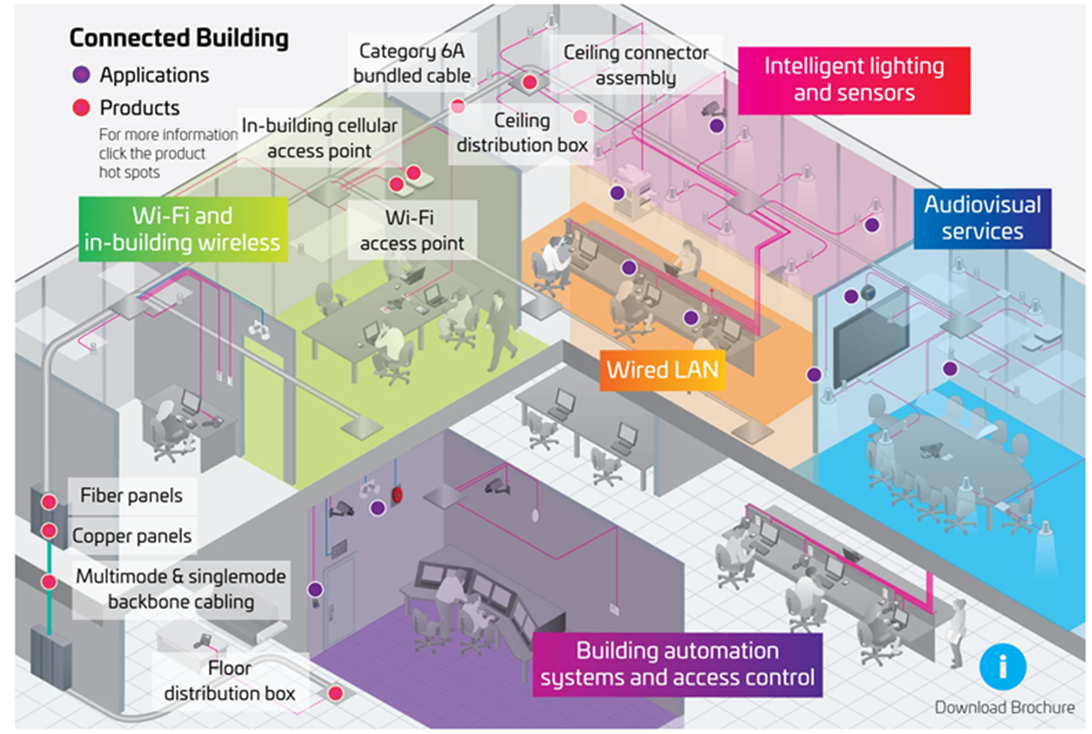While it’s impossible to truly future-proof a network against challenges that don’t yet exist, enterprise networks can tilt the odds in their favor as they adapt to new application demands, more connected devices and multi-network convergence—with the right infrastructure approach.
Cat 6A, is versatile, capable and plays an important role in network infrastructure moving forward. But before looking at Cat 6A’s advantages, let’s first discuss the importance of versatility as a strategic concept.
WD-40® lubricant, which is owned, branded and manufactured by the WD-40 Manufacturing Company in San Diego, California, is one of the most versatile products on the market today—but it wasn’t supposed to be. It was developed to solve one specific problem—and nothing more. It was originally developed as a rust-prevention solvent and degreaser for the aerospace industry.
That was in 1953. Today there are hundreds of known uses for WD-40… and people are coming up with new ones all the time. Squeaky door hinge? WD-40. Want to clean bugs off your car’s grille? WD-40. Got weeds in your lawn? WD-40—and the list goes on and on. If WD-40 is known for anything, it’s for being versatile far beyond its original intent.
Cat 6A is considered by many to be most versatile twisted pair cable available—for good reason—and like WD-40, it too continues to find new uses beyond its original intent.
You see, Cat 6A was also developed to solve one particular problem: achieving 10-Gigabit Ethernet out to 100 meters. In order to do this, we needed to develop better alien crosstalk mitigation as the bandwidth of the application shifted from 250 MHz to 500 MHz.
Alien crosstalk mitigation. That’s the impetus. Without it, there’s no Cat 6A. But because of it, we have the ability to deploy all countless enterprise applications with confidence that these different systems will operate consistently as intended.
This is especially true as connectivity moves from the wall to the ceiling. When you think of the variety and complexity of these different applications—such as Wi-Fi 6, in-building wireless and a multitude of PoE devices—it becomes easy to see why you need the most robust infrastructure available.
These days, it seems like everything is running over twisted pair. Proprietary infrastructure has converged—four-pair cabling now supports the majority of building applications, leading to smart buildings and a whole new way to manage these applications.

From A/V services to indoor wireless networks, from wired LAN to building automation, sensor networks and access control, Cat 6A has almost as many “off-label” uses as WD-40.
Of course, not all applications need Cat 6A—or its 10-gigabit bandwidth—but many need at least multi-gigabit, and you don’t always know from the beginning which applications you will need on each run of cable.
Many times, people either trying to save money (or just being contrarians) try to claim that just about everything can run on plain old Cat6, and that very few applications require speeds above 1 gigabit.
However, most important is this simple fact: we have no idea what new applications we’ll be running over our networks over the coming decades. Twenty years ago, we needed Cat 6A to do one thing. Today, there are a myriad of applications running over twisted pair, many of which require Cat 6A’s exceptional capabilities and nothing less. With the recent explosion of AI, and the ongoing evolution of the smart building, those who still promote Cat6 over Cat 6A are quickly running out of solid reasons for their preference.
When you look at the various standards ratified over the past few years, you begin to see a common thread where Cat 6A is either recommended or required. It’s only a matter of time before we see this specification across the board for all applications and spaces relying on twisted pair for their infrastructure.
From applications like Wi-Fi 6 and PoE++ to spaces such as data centers, healthcare and education, the strong recommendation for Cat 6A continues to grow and evolve.
Let’s look at a few of the applications driving the demand for versatility and capabilities that Cat 6A is best suited for:
- Wi-Fi 6/6E:While Cat5e and Cat6 cabling could support early Wi-Fi 6 deployments with 2.5GBASE-T or 5GBASE-T, this is not expected to be the case in the future. Today’s 802.11ax (Wi-Fi 6) access points allow a maximum speed of 6.77 Gbps, requiring a 10GBASE-T connection to support the highest possible data rate. TSB-162-A, Telecommunications Cabling Guidelines for Wireless Access Points, also recommends running at least Cat 6A or higher cabling to all wireless access points.
- High-performance computing and edge compute:Many industry sectors now utilize high-performance computing platforms to support highly bandwidth-intensive applications such as streaming video, medical imaging, centralized applications, high-end graphics, visualization technologies and data clustering. In addition, edge compute continues to grow as advanced applications demand it. Cat 6A’s expanded data capacity will be key to enabling these capabilities.
- Storage area networks (SAN)/network attached storage (NAS): 10-Gigabit Ethernet enables cost-effective, high-speed infrastructure for both network-attached storage (NAS) and storage area networks (SAN). 10-Gigabit Ethernet can offer equivalent or superior data-carrying capacity at latencies similar to many other storage networking technologies, including Fiber Channel, ATM OC-3, OC-12 and OC-192, and InfiniBand.
- Multi-site collaboration:Collaboration tools are emerging that enable conference participants to write or draw on a blank slide, connect to a website and engage in private communication with the conferencing host or any other participants. These collaborative tools will increasingly require more bandwidth, and 10-Gigabit Ethernet connections will be the primary link for enabling multi-site collaboration within an enterprise.
- Grid computing: Grid computing makes “spare” desktop CPU horsepower available across the network to large jobs that require it. Grid computing effectively provides the horsepower “across the network” to support such applications. This demands high-speed connections among participating compute platforms, making Cat 6A the logical Ethernet choice.
Looking towards a more resilient, future-ready enterprise network
Looking back on the versatility and performance of Cat 6A cabling, we see that it has enabled the development and deployment of many bandwidth-hungry applications that today’s enterprises cannot do without. And it is not finished yet—it remains the recommended infrastructure for modern new-builds and promises to remain relevant for many years to come. The evidence is clear in the sales volume that continues to grow, almost two decades after the initial draft of the standard.
While you may never be able to completely future-proof your enterprise network, you can ensure it is future-ready with the right infrastructure strategy.
Cat 6A is versatile and capable. Think of it as the WD-40 of network infrastructure.
To learn more about how CommScope’s SYSTIMAX®, Uniprise® and NETCONNECT® Cat 6A portfolios can help you build a more resilient and adaptable network, check out our Cat 6A Resource Page.
© 2024 CommScope, LLC. All rights reserved. CommScope and the CommScope logo are registered trademarks of CommScope and/or its affiliates in the U.S. and other countries. For additional trademark information see https://www.commscope.com/trademarks. Wi-Fi, Wi-Fi 6 and Wi-Fi 6E are trademarks of the Wi-Fi Alliance. WD-40 is a trademark of the WD-40 Manufacturing Company. All product names, trademarks and registered trademarks are property of their respective owners.
